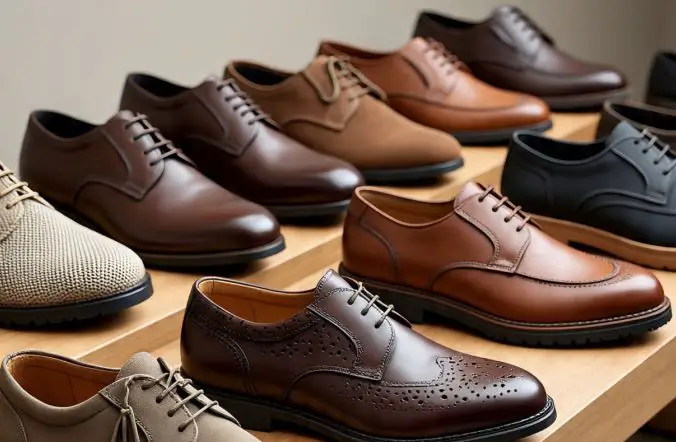Last updated on November 24th, 2025 at 10:04 am
Men’s shoes define more than just your style; they shape comfort, confidence, and presence. At Gentsways, this complete guide covers styles, proper fit, and essential care every man should know.
When you choose a pair of shoes, you are doing more than covering your feet. You are making a statement about your style, confidence, and priorities.
The right footwear ties an outfit together and supports your body through everyday movement.
Poorly chosen shoes can leave you uncomfortable or even affect your posture and long-term health.
A men’s shoe guide gives you direction on what works best for different occasions and how to make choices that last.
From polished dress shoes for formal settings to casual sneakers, loafers, and boots, each option has its place.
Fit, material, and construction play a large role in both comfort and appearance.
With the right knowledge, you can select shoes that reflect your personality, complement your wardrobe, and remain reliable through consistent care.
Table of Contents
- The Role of Shoes in Men’s Style
- Types of Men’s Shoes
- Men’s Shoe Styles
- Materials and Construction
- Fit and Comfort
- Choosing the Right Size
- The Right Shoe for the Right Occasion
- Color and Style Coordination
- Men’s Shoes Care and Maintenance
- Foot Health and Footwear
- Buying Guide
- Trends in Men’s Shoe Fashion
- Conclusion
- Frequently Asked Questions
The Role of Shoes in Men’s Style
Your shoes speak before you do. They set the tone for how people perceive you, reflecting your personality and approach to life while seamlessly connecting style and function.
First Impressions Matter
The shoes you wear shape how people see you in personal and professional settings.
Polished dress shoes show care, while casual loafers signal a relaxed attitude.
Your choice communicates confidence and priorities, helping you leave the impression you want every time.
Balance of Fashion and Function
Men’s shoes offer options from dress shoes to sneakers, letting you match footwear to the occasion.
Oxfords and loafers enhance formal looks, while sneakers create a casual vibe.
Choosing the right shoes balances style and comfort without compromising the image you project.
Shoes as Self-Expression
Your shoes show your lifestyle and values. Sustainable brands indicate environmental awareness, while heritage footwear reflects appreciation for craftsmanship.
Footwear communicates subtle messages, influences how people respond to you, and boosts confidence, helping you present yourself authentically every day.
Types of Men’s Shoes
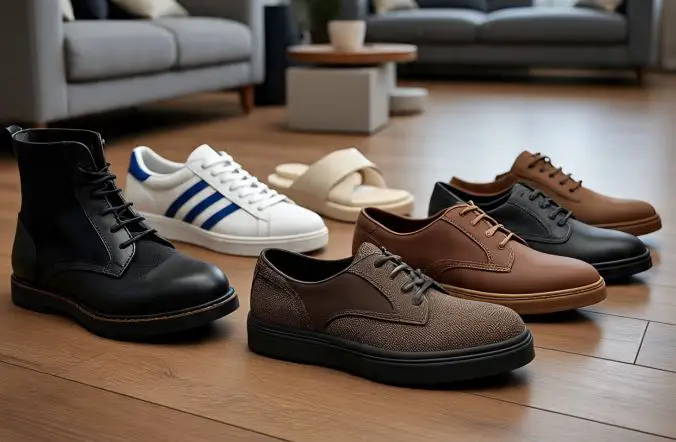
Types of men’s shoes refer to categories based on purpose and function. They include dress shoes, casual shoes, boots, athletic shoes, and sandals.
Each type serves a specific need, from formal events to active or relaxed daily wear.
The type of shoes you choose sets the foundation for your wardrobe and daily comfort.
Dress shoes, like Oxfords and Derbies, suit formal occasions and business settings, giving your outfit a professional edge.
Casual shoes, including loafers, moccasins, and slip-ons, work for relaxed environments or weekends.
Boots, from Chelsea to Chukkas, handle seasonal changes and add structure to your look.
Athletic shoes such as sneakers and trainers support active days while keeping your style fresh. Sandals and slippers fit warm weather or indoor comfort.
Each type serves a purpose, helping you match footwear to your activities, outfit, and mood.
Knowing types ensures you select shoes that fit the occasion, maintain comfort, and express your personality through practical choices.
Men’s Shoe Styles
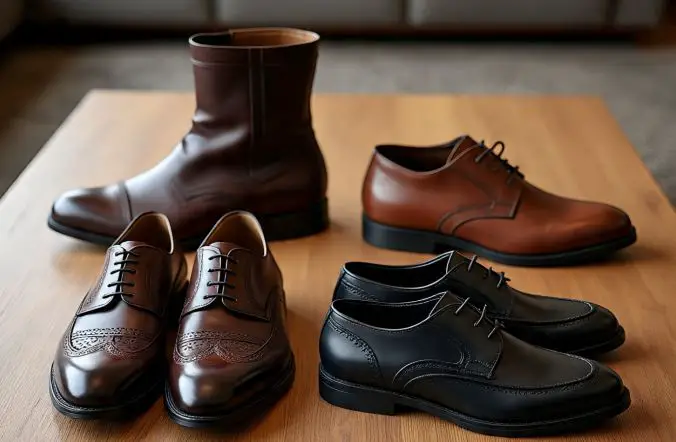
Styles of men’s shoes refer to the visual design and aesthetic details within each type.
Examples include Oxfords, Derbies, Brogues, Loafers, Chelsea boots, and Chukkas.
Style communicates personality, fashion sense, and attention to detail while complementing the shoe’s function.
Style is where function meets fashion, letting your personality show in every step.
Oxfords, with closed laces, convey formality, while Derbies with open laces offer a slightly relaxed look.
Brogues feature decorative perforations that add detail without overdoing it. Loafers slip on easily and suit casual or semi-formal wear.
Chelsea boots bring sleek lines and versatility, perfect for both office and weekend outfits.
Sneakers vary from minimalist designs to bold athletic options, letting you signal modernity or laid-back confidence.
Chukkas and desert boots provide casual sophistication and pair well with jeans or chinos.
Paying attention to style helps you fine-tune your appearance, ensuring your shoes communicate the right balance of personality, professionalism, and comfort.
Related Posts
Corporate Dressing Guide for Older Men
Men’s Belt Guide: Types and How to Wear Them
How to Take Care of Your Dress Shoes
Materials and Construction
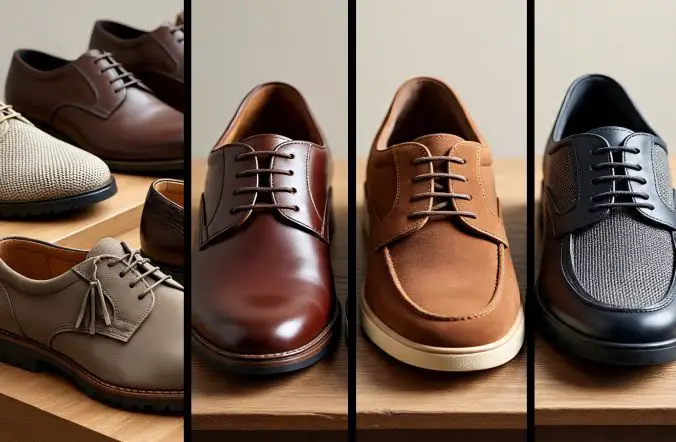
Knowing what goes into your shoes helps you choose pairs that last, feel comfortable, and support your daily routine.
Materials and construction determine how your shoes look, perform, and age, giving you confidence in both style and comfort.
Leather Types
Leather is a top choice for men’s shoes because it combines strength, comfort, and style.
Full-grain leather keeps its natural texture and develops character with time.
Top-grain leather is sanded and treated for a smooth finish and stain resistance.
Suede adds softness and casual appeal, while patent leather gives a glossy finish for formal events.
Understanding leather types helps you pick shoes that match your needs.
Synthetic Materials
Canvas and mesh are common in casual and athletic shoes. Canvas is lightweight and breathable, ideal for warm weather or relaxed outfits.
Mesh improves ventilation, keeping your feet cool during physical activities.
These materials are easy to clean and more affordable than leather, though they may wear faster.
Choosing synthetic shoes depends on activity, comfort, and how you want your style to read.
Sole Materials
The sole affects how your shoes feel and perform. Rubber soles absorb shock and give traction for everyday walking.
Leather soles create a classic look but can be slippery on smooth surfaces.
Crepe soles are lightweight and textured, offering comfort and a retro feel.
The right sole improves walking experience and pairs well with different outfits.
Construction Methods
Construction determines durability and flexibility. Goodyear welt shoes allow resoling and long-term use.
The Blake stitch gives a sleek and flexible design. Cemented shoes are more budget-friendly but may wear faster.
Understanding construction techniques helps you invest in shoes that last while keeping comfort and style.
Fit and Comfort
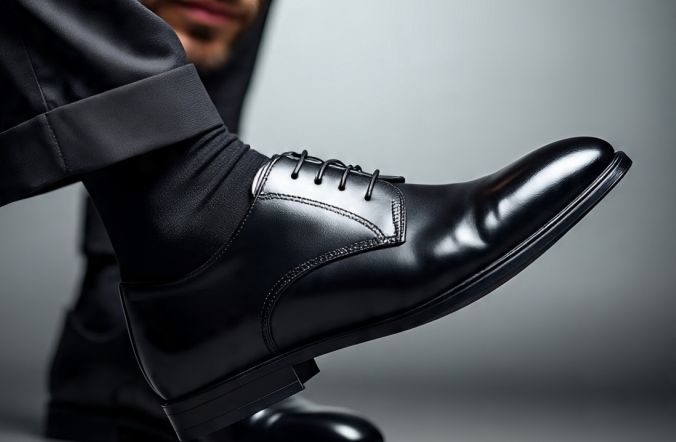
The right fit in men’s shoes affects more than comfort. It impacts foot health, posture, and how you move through your day.
Knowing your foot size and shape ensures that shoes support you properly while letting you wear them confidently for long hours.
Measuring Your Feet
Start by measuring both feet, as size can vary. Stand on paper and trace your longest toe and heel. Measure the length and width accurately.
This helps you find shoes that truly fit, avoiding discomfort, blisters, and long-term foot issues caused by poorly sized footwear.
Arch Support and Toe Box
Your arch and toe box shape matter. Shoes without proper arch support can cause fatigue or alignment problems.
Narrow toe boxes may lead to bunions or plantar pain. Picking shoes suited to your arch type ensures comfort and reduces strain throughout the day.
Testing Fit and Walking
Try walking in shoes before buying. Ensure a thumb’s width between toes and shoe end, and that your heel fits snugly.
Breathable materials help keep feet cool and reduce irritation during extended wear. Comfort while moving signals a good fit.
Foot Shape and Long-Term Health
Different foot types need different support. Flat feet benefit from stronger arch support, and high arches from cushioned soles.
Regularly checking fit and comfort helps prevent injuries, supports posture, and keeps your shoes working for your lifestyle.
Choosing the Right Size
Selecting the right shoe size affects comfort, appearance, and overall foot health.
Shoes that fit properly prevent pain, reduce fatigue, and help you move confidently throughout the day. Begin by measuring both feet, as size can vary slightly.
Stand on paper, trace your foot’s outline, and mark the heel and longest toe.
Measure the length in inches or centimeters and use the larger foot when choosing a size to avoid tightness or discomfort.
Try shoes on later in the day when your feet may be slightly swollen, which provides a more accurate fit.
Check that your toes have enough room to move, roughly a thumb’s width from the shoe’s end, and that the heel fits snugly without slipping.
Width also matters, so consider narrow, standard, or wide options.
Sizes vary across brands, shoe types, and international systems, so consult sizing charts and reviews before buying. Proper sizing ensures comfort, health, and style.
The Right Shoe for the Right Occasion
Choosing the right shoe for each occasion affects both style and comfort.
For formal events like business meetings, weddings, and black-tie gatherings, leather oxfords, brogues, or polished dress shoes convey professionalism and elegance while complementing your outfit.
In business casual settings, loafers and derbies provide comfort and a polished look, with leather offering refinement and suede adding relaxed charm.
For everyday casual wear, sneakers or casual boots balance style and ease, with clean sneakers suiting jeans and t-shirts, and desert boots pairing with smart-casual outfits.
Seasonal factors also matter, with breathable materials for summer and insulated boots for winter.
Understanding the expectations of each occasion helps you choose shoes that keep you comfortable, confident, and stylish.
Color and Style Coordination
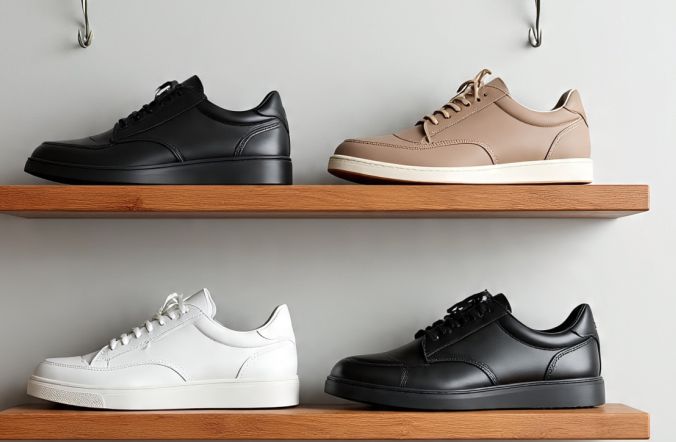
Choosing the right colors and styles for your shoes shapes your overall look.
For formal outfits, black shoes pair well with dark suits, while brown or tan shoes complement lighter shades, adding balance and professionalism.
Casual outfits, especially with jeans, allow more flexibility. Loafers or brogues create a smart-casual feel, while sneakers give a relaxed appearance.
Matching shoe color to denim wash helps maintain a cohesive style.
Coordinating your belt with your shoes in color and material adds a polished touch, reinforcing attention to detail.
Color choice also carries meaning: neutral tones convey reliability and suit formal settings, while bold colors express confidence and individuality.
By considering occasion, outfit, and impression, you can select shoes that not only complete your wardrobe but also reflect your personal style, helping you move through any setting with confidence and elegance.
Men’s Shoes Care and Maintenance
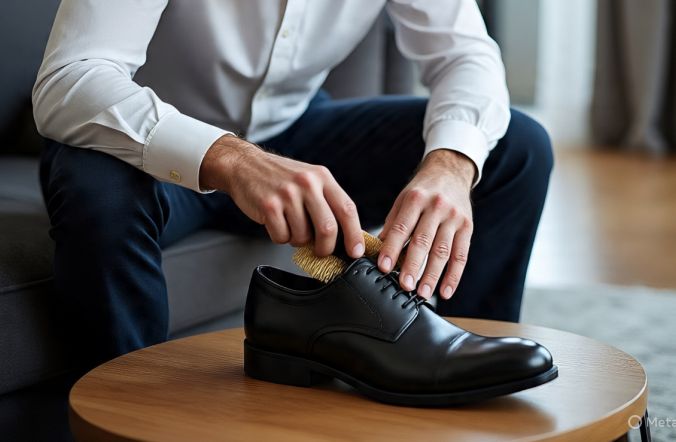
Taking care of your shoes ensures they stay comfortable, look polished, and last longer.
Leather shoes should be cleaned with a soft brush, wiped with a damp cloth for stains, and conditioned regularly to prevent cracking.
Polishing with a matching color keeps them smooth and protected from moisture. Suede shoes need gentle care with a suede brush and eraser for stains, along with a water-repellent spray to avoid damage.
Fabric or canvas shoes can be spot-cleaned with mild detergent and water, following manufacturer instructions to prevent soaking.
Proper storage using cedar shoe trees maintains shape and absorbs moisture, while rotating shoes reduces wear.
Repairs such as resoling or reconditioning can extend the life of your footwear.
Consistent care preserves both style and functionality, keeping your shoes ready for any occasion. See more on men’s shoes care and maintenance.
Foot Health and Footwear
The shoes you choose directly affect foot health. Poorly fitted or unsupportive footwear can lead to blisters, bunions, and plantar fasciitis, causing discomfort and long-term problems.
Blisters arise from friction, bunions worsen with tight shoes, and plantar fasciitis results from insufficient arch support or rigid soles.
Prioritizing shoes with proper arch support, cushioning, and a shape that matches your foot can reduce strain and prevent injury.
Breathable materials help control moisture, lowering the risk of fungal infections, while cushioned soles absorb shock during walking or running.
Heel height matters too, as excessive elevation can stress toes and arches. Selecting shoes with moderate heels and proper support enhances comfort, balance, and long-term foot health.
Understanding your foot type and shoe requirements ensures safer, more comfortable steps every day. More on how your footwear affects your foot health.
Buying Guide
When buying men’s shoes, focusing on quality ensures style, comfort, and durability. Start by examining craftsmanship: stitching, finish, and construction reveal a shoe’s longevity.
Goodyear welt construction adds durability and allows resoling.
Material choice is equally important; full-grain leather molds to your foot and breathes, suede looks stylish but needs care, while synthetics may be less comfortable and durable.
Consider price versus value; investing in quality shoes pays off long-term, especially for versatile pairs that suit multiple occasions.
Shopping online requires checking size charts, reading reviews, and understanding return policies, while in-store shopping allows immediate fit and quality assessment.
Knowing trusted brands like Allen Edmonds, Clarks, and Alden ensures reliable options, while newer brands like Greats and Thursday Boot Company offer stylish, affordable alternatives.
Smart choices balance style, comfort, and budget.
Trends in Men’s Shoe Fashion
Men’s shoe fashion keeps changing, but certain styles stay timeless. At Gentsways, you learn how modern trends and classic choices combine to shape a shoe collection that balances comfort, style, and durability.
Sustainable Shoes: Eco-friendly Fashion with Purpose
Sustainability is shaping men’s shoe fashion. More brands now use recycled leather, organic cotton, or plant-based materials to reduce waste.
You benefit by getting shoes that look stylish while supporting responsible production.
These eco-conscious pairs are no longer niche; they’re part of mainstream fashion, meaning you can wear them confidently to both casual and business settings without sacrificing quality.
Sneakers with Style: Blending Comfort and Fashion
Sneakers are no longer limited to gyms or casual days. Today’s sneaker trend is about merging comfort with polished designs that work in semi-formal settings.
Pair clean leather sneakers with chinos for office wear, or keep it casual with jeans.
Designers now create sneakers with refined lines, letting you bridge the gap between relaxed style and professional looks effortlessly.
Classics That Never Fade: Oxfords, Brogues, and Desert Boots
While trends shift, some shoes remain wardrobe anchors. Oxfords remain the standard for formal events, brogues add personality with their detailing, and desert boots deliver casual comfort with sophistication.
These classics ensure you always have dependable options, no matter the occasion.
Adding a mix of both new styles and timeless icons strengthens your shoe rotation and keeps your outfits sharp.
Conclusion
Men’s shoes do more than complete your outfit; they influence your confidence, comfort, and even long-term health.
The right choice supports your posture, protects your feet, and communicates your priorities without saying a word.
From classic Oxfords for formal occasions to sneakers, loafers, and boots for casual days, each pair serves a purpose in your wardrobe.
Quality materials, proper fit, and regular care determine how long your shoes last and how well they perform.
By paying attention to craftsmanship, style, and maintenance, you build a collection that works for every setting.
With informed choices, your shoes become a reflection of your lifestyle and a reliable foundation for your personal style.
Frequently Asked Questions
How many pairs of shoes should a man own?
A man should ideally own 5 to 7 pairs of shoes, covering dress, casual, athletic, and seasonal footwear for versatility, comfort, and style balance.
What’s the difference between Oxfords and Derbies?
Oxfords have closed lacing for a sleeker, formal look, while Derbies feature open lacing, offering a more relaxed, versatile style suitable for casual and semi-formal wear.
Can sneakers be formal?
Yes, minimalist leather sneakers in neutral tones can work in smart-casual or business-casual settings, but they’re not appropriate for strictly formal occasions like weddings or interviews.
How often should I replace my shoes?
Replace shoes every 12 to 18 months, depending on wear, usage, and material. Signs like worn soles, loss of structure, or discomfort signal it’s time.
References
Pyo Merez is a men’s lifestyle enthusiast and writer about the gentleman’s place and impact on society. Raised by a distinguished gentleman dad, he offers unique insights into how the mind of a gentleman works and how societal norms shape gentlemen’s identity and vice versa.
Through his insightful articles, Pyo taps into the depths of gentleman culture to provide perspectives on etiquette and manners in modern society.

